ESPON-TITAN – Natural hazards, economic impacts and approaches to innovative risk management in Europe
- Projects

In April 2021, the final report of ESPON-TITAN – Territorial Impacts of Natural Disasters was delivered to ESPON EGTC. Between September 2019 and March 2021, the ESPON-TITAN project partners analysed the territorial patterns of natural hazards and their direct and indirect economic impacts in Europe, supported by a vulnerability assessment, 8 regional case studies and a policy analysis. The project was completed by policy recommendations for considering territorial vulnerability and economic impacts of disasters into DRM/CCA strategies as part of an integrated spatial planning.
In ESPON-TITAN, four main natural hazards, which most heavily affect the European territory, were analysed, to be mentioned: (river) floods, windstorms, drought and earthquakes. The analysis of the distribution of aggregated hazards was based on the combination of normalised hazard indexes weighed with their cumulative damage costs in the period 1981-2010. As part of the findings, floods and storms outstand as hazards contributing to nearly 76% of the damage and losses, followed by droughts and earthquakes (24% both). The spatial distribution of the economic impacts (based on data of the period 1995-2017) indicates that Central and Eastern European (CEE) and South-Eastern European (SEE) countries tend to be relatively more affected by these natural hazards, in economic terms, than most of the rest of the European territory. Additionally, a territorial vulnerability assessment was developed at a European level. Results clearly show that Eastern and Southern European areas are the most vulnerable areas to natural hazards, which largely matches the key insights from the economic impact analysis.
Moreover, the project identified the policy and planning practice of DRM and CCA in Europe. The analysis, which was one of the main tasks of the IRPUD team, was based on a multi-methodological approach. A desk-top analysis, which focused on existing studies of DRM and CCA practices in Europe was combined with primary data from the case studies analysis (document analyses and expert interviews). Results showed that a multi-risk and criticality-oriented spatial approach to DRM that also includes the multiple dynamics of changing hazards, exposure and vulnerability is still not common. The research indicates that the effectiveness of instruments can be tackled by supporting innovations in the assessment as well as supporting the implementation of instruments.
ESPON-TITAN illustrated the findings through eight representative case studies, of which the Dresden region and the Alpine region case studies were undertaken by the IRPUD team. The case studies allowed the identification and description of successful cooperation mechanisms, qualitative contexts of DRM and CCA, and estimation of effectiveness of policies and instruments, which are always context-dependent due to the heterogeneity of legal-administrative systems and cultural settings throughout Europe.
Under the lead of the IRPUD team, the main outcomes were translated into policy recommendations, framing the political debate on how the potential impacts of natural hazards affect the territory and what the consequences of having coherent policies in place maybe, at the same time reinforcing the need of integrating DRM and CCA strategies into territorial planning instruments.






